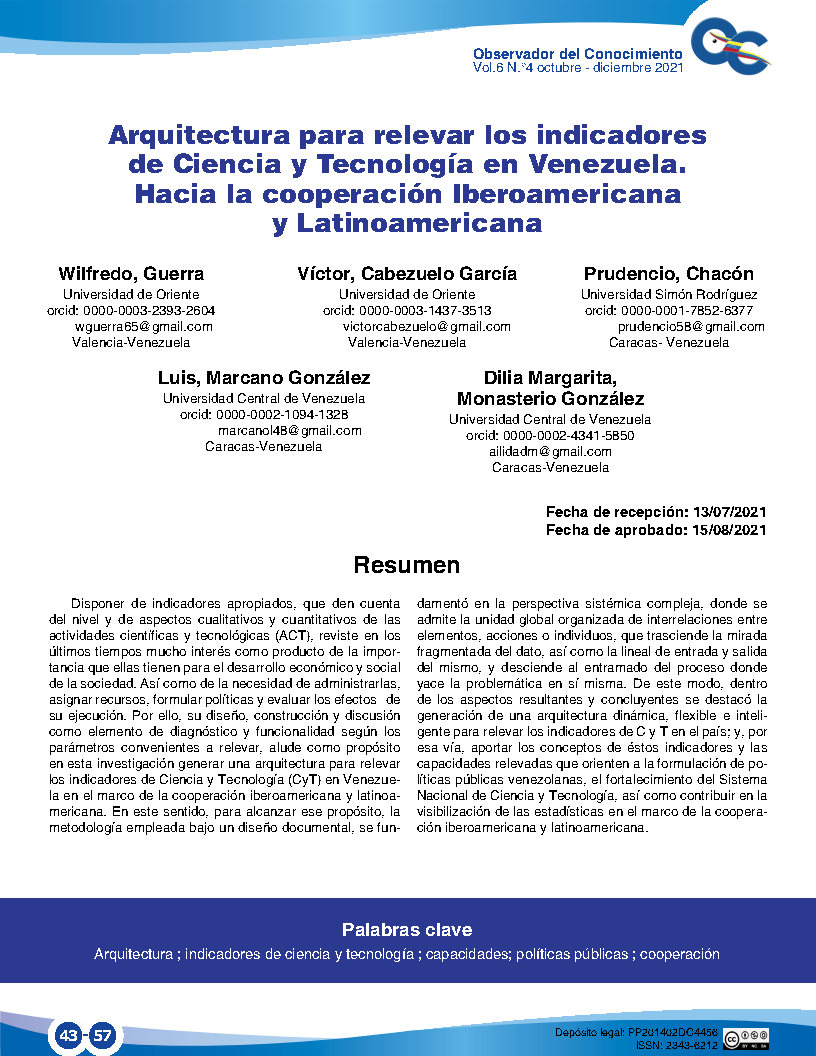Architecture to survey the Science and Technology Indicators in Venezuela. Towards Ibero-American and Latin American cooperation
Keywords:
Architecture, science and technology indicators, capacities, public politics, cooperationAbstract
Having appropriate indicators that account for the level and qualitative and quantitative aspects of scientific and technological activities (ACT) has been of great interest in recent times as a result of the importance they have for the economic and social development of society. . As well as the need to administer them, allocate resources, formulate policies and evaluate the effects of their execution. Therefore, its design, construction and discussion as an element of diagnosis and functionality according to the convenient parameters to be surveyed, alludes as the purpose of this research to generate an architecture to survey the Science and Technology Indicators (S&T) in Venezuela within the framework of cooperation Ibero-American and Latin-American. In this sense, to achieve this purpose, the methodology used under a documentary design was based on the complex systemic perspective, where the organized global unity of interrelationships between elements, actions or individuals is admitted, which transcends the fragmented look of the data, thus as the linear input and output of the same, and descends to the framework of the process where the problem itself lies. In this way, among the resulting and conclusive aspects, the generation of a dynamic, flexible and intelligent architecture to assess the S&T Indicators in the country was highlighted; and, in this way, contribute the concepts of these indicators and the surveyed capacities that guide the formulation of Venezuelan public policies, the strengthening of the National Science and Technology System, as well as contribute to the visibility of statistics in the framework of cooperation iberoamerican and latinamerican.
Downloads
References
Ahumada, E. y Perusquia, J. (2016). Inteligencia de negocios: estrategia para el desarrollo de competitividad en empresas de base tecnológica. Contaduría y Administración 61 (2016) 127–158.
Barrere, R. (2021). El reto de los indicadores en una sociedad que cambia rápidamente". Organización de Estados Iberoamericanos para la Educación, la Ciencia y la Cultura. Recuperado en: https://oei.int/oficinas/portugal/noticias/ricyt-o-desafio-dos-indicadores-numa-sociedade-de-mudancas-rapidas
Curto, J. y Conesa, J. (2011). Introducción al Business Intelligence. Barcelona: Editorial UOC.
Real Academia Española (2020). Arquitectura. En: https://dle.rae.es/arquitectura
Gil, M. (2021). Tecnología y su relación con otras áreas de conocimiento. Recuperado en: https://webcache.googleusercontent.com/search?q=cache:YiyRuLRYz90J:https://docplayer.es/211183982-Tecnologia-y-su-relacion-con-otras-areas-de-conocimiento.html+&cd=14&hl=es-419&ct=clnk&gl=ve
Holness, G. (s/f). Inteligencia de Negocio: La Estrategia que Necesitas en tu Empresa. Recuperado en: https://www.bpartnerslab.com/blog/inteligencia-de-negocio-como-estrategia
Ministerio del Poder Popular para la Ciencia, Tecnología e Industrias Intermedias (2010) Código de Ética para la Vida. Caracas. Venezuela.
Moreno, L. (2017). Introducción al Business Intelligence. Recuperado en: https://docplayer.es/709686-Introduccion-al-business-intelligence.html
Morin, E. (1997). El Método I. La naturaleza de la naturaleza. Cátedra. Madrid. España.
Organización de las Naciones Unidas para la Educación, la Ciencia y la Cultura. (2021). La ciencia al servicio de la sociedad. Recuperado en: https://es.unesco.org/themes/ciencia-al-servicio-sociedad
Organización de las Naciones Unidas para la Educación, la Ciencia y la Cultura (2005). Declaración universal sobre Bioética y Derechos Humanos. Recuperado en: http://portal.unesco.org/es/ev.phpURL_ID=31058&URL_DO=DO_TOPIC&URL_SECTION=201.html.
Pulido, N. y Lacoviello, M. (2020). ¿Mejora continua o innovación disruptiva? Boletín Tecnología para la Organización Pública (8), 1-5. Recuperado el 19 de Junio de 2021 en: http://www.top.org.ar/ECGP/FullText/000020/20267.pdf
Ronda, R. (2008). Arquitectura de Información: análisis histórico-conceptual. Recuperado en: http://www.nosolousabilidad.com/articulos/historia_arquitectura_informacion.htm
Shapiro, C. y Varian, H. (1999). El dominio de la información: una guía estratégica para la economía de la red. Barcelona: Antoni Bosch Editor.
Zapata-Cantú, L. E. (2004). Las determinantes de la generación y la transferencia del conocimiento en pequeñas y medianas empresas del sector de tecnologías de información en Barcelona [tesis doctoral]. Barcelona: Universitat Autónoma de Barcelona.
Zavarce, C. (2013). Strategic Architecture: How aligning with organization strategy? . Recuperado en: www.revistaorbis.org.ve / núm 25 (año 9) 21- 32

Downloads
Published
How to Cite
Issue
Section
License

This work is licensed under a Creative Commons Attribution-NoDerivatives 4.0 International License.







